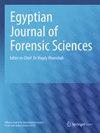枪弹残留物(GSR)检测技术的时间顺序研究:叙述性回顾
IF 1.3
Q3 MEDICINE, LEGAL
引用次数: 0
摘要
在枪支犯罪的调查和重建中,通过分析枪支残留的有机和无机成分来确定射击距离、射击时间和射击残留的持久性是至关重要的。然而,传统的颜色测试和相关技术的GSR分析是破坏性的,有有限的灵敏度和选择性。该审查给出了一个详细的和按时间顺序的描述,所有的方法使用到目前为止,以及未来方面的GSR检测技术。重点介绍了光谱法和光谱学分析技术在GSR评价中的应用。研究分为不同的部分,从传统的颜色测试到GSR分析中使用的当前技术。虽然这些技术存在不一致性和不可靠性,但本研究中讨论的当前方法使用激光诱导击穿光谱(LIBS)、表面增强拉曼散射(SERS)、离子迁移率光谱(IMS)和基于电化学传感器的方法具有重大的GSR检测潜力。解决这些限制将提高执法部门的法医能力,并在调查期间为法医实验室提供额外的优势。它还将加强在刑事调查中使用这种光谱数据。这里讨论的技术有能力检测GSR的有机和无机成分,这些成分有可能将GSR颗粒与发射的弹药类型联系起来。这些方法的有效性和可靠性已被证明能够区分目前用于GSR检测和鉴定的标准法医分析技术中已知的潜在误报。本文期望对与当前GSR分析研究范围相关的新方法进行系统研究,当在实践中得到充分发展和实施时,将有助于法医科学家检测,识别和分析GSR,使其成为一种新的重要证据类型。本文章由计算机程序翻译,如有差异,请以英文原文为准。
A chronological study of gunshot residue (GSR) detection techniques: a narrative review
The investigation and reconstruction of firearm-related crimes for the determination of the shooting distance, time since fire, and gunshot residue (GSR) persistence using the analysis of GSR comprising organic and inorganic components are crucial. However, the conventional color tests and allied techniques for GSR analysis are destructive and have limited sensitivity and selectivity. The review gives an elaborate and chronological description of all the methods used to date along with the future aspects of GSR detection techniques. It highlights the significant methods of spectrometry and spectroscopy applied as analytical techniques for the evaluation of GSR. The study is divided into various sections, ranging from the conventional color tests to the current techniques used in GSR analysis. While there is inconsistency and unreliability in these techniques, the current approaches discussed in this study using laser induced breakdown spectroscopy (LIBS), surface enhanced Raman scattering (SERS), ion mobility spectrometry (IMS), and electrochemical sensor-based methods have significant potential for GSR detection. Addressing such limitations will enhance the forensic capabilities of law enforcement and provide an added advantage to forensic laboratories during an investigation. It will also reinforce the use of such spectroscopic data in a criminal investigation. The techniques discussed here have the capability to detect both organic and inorganic components of GSR that has the potential to link GSR particles to the type of ammunition discharged. The validity and reliability of these approaches have proved to establish their capability to differentiate between potential false positives known for standard forensic analysis techniques currently used for GSR detection and identification. The paper anticipates a systematic study of the novel methodologies relevant to the current scope of research concerning GSR analysis, when fully developed and implemented in practice will help forensic scientists to detect, identify, and analyze GSR, making it a new and important type of evidence.
求助全文
通过发布文献求助,成功后即可免费获取论文全文。
去求助
来源期刊

Egyptian journal of forensic sciences
MEDICINE, LEGAL-
CiteScore
2.00
自引率
0.00%
发文量
51
审稿时长
17 weeks
期刊介绍:
Egyptian Journal of Forensic Sciences, the official publication of The International Association of Law and Forensic Sciences (IALFS), is an open access journal that publishes articles in the forensic sciences, pathology and clinical forensic medicine and its related specialities. The journal carries classic reviews, case studies, original research, hypotheses and learning points, offering critical analysis and scientific appraisal.
 求助内容:
求助内容: 应助结果提醒方式:
应助结果提醒方式:


